

If you tune into the Internet
Movie Database and search for details on Daimajin,
you'll see the User Review that begins "this is that stone
statue movie that we've all seen as kids." Given that the reader
is of the same age strata, this is pretty much correct; AIP-TV imported
this Japanese fantasy under the title Majin, Monster of Terror,
just so that there could be no doubts that it was a monster movie.
Indeed, I first encountered Daimajin under
that title on Project: Terror, the same show which introduced
me to the likes of Reptilicus and Space
Monster. The Monster of Terror sobriquet helped,
too, because my little 12 year old brain kept wondering, "Where's
this Monster of Terror?" This is but one of the things that
make the Majin films different from other Kaiju films. The
other is the fact that the movies take place in Japan circa (approximately)
the 17th century.
The movie opens with a household of peasants cowering
during a series of earth tremors that are interpreted as the escape
attempts of "the Majin of the Mountain", a spirit trapped
within said geological formation. The entire village gathers at
their shrine to pray Majin will remain imprisoned. This torchlit
parade is observed by the local feudal boss, Lord Hanabasa, a good
and just type. It is also observed by his chamberlain, Samanosuke
(Yutaro Gomi), who is an evil and unjust type. Samanosuke has been
waiting for just such a diversion to stage a coup d'etat.
As the villagers pray their little hearts out, Samanosuke
and his henchmen attack and slaughter Hanabasa and his wife, but
their son and daughter escape, aided by the heroic samurai Kogenta
(Jun Fujimaki). Meanwhile, back at the shrine, Samanosuke's men
break up the prayer meeting, forbidding all such gatherings in the
future. The priestess issues a dire warning against forbidding the
prayers, but the bad guys (being bad guys and all) ignore her.
Discouraged, the priestess, Shinobu, goes home, only
to find herself the last hope of Kogenta and the two children. She
takes them up the side of the mountain, into forbidden territory,
where the stone idol which is Majin stands, half-buried in the living
rock. Near this idol is an ancient temple - the only safe place
for the children, as only Shinobu knows of its existence.
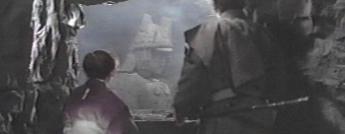
Ten years pass, and the children grow to adulthood.
The son, Tadafumi (Yoshihiko Aoyama) reaches his 18th birthday,
and high time to reclaim his throne, to his thinking. In fact, the
last ten years have been pretty hard on the villagers: Samanosuke
is the ideal poster boy for tyranny, and he is currently using every
man in the starving village as slave labor to build his fortress.
The place is ripe for revolution, and surviving Hanabasa retainers
are starting to filter in on the tenth anniversary of the coup.
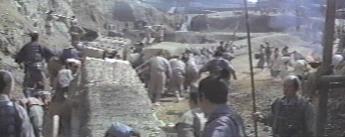
Kogenta journeys to the village to try to gather the
old retainers, but gets himself captured. A Boy (yeah, yeah, I forgot
to write down his name) gets word to Tadafumi and his sister, Kozasa
(Miwa Takada) that their friend is a prisoner. Tadafumi, being a
brave young samurai, tries to rescue him, only to discover it's
all a trap laid by Samanosuke. With both the men under arrest and
awaiting execution, Shinobu tries to talk some sense into the tyrant,
who is drinking way too much and becomes incensed at all this talk
of the god of the mountain; he murders the priestess and orders
the idol demolished, to all the more thoroughly demoralize the villagers.
The crew that travels up the mountain to smash Majin
accidentally discovers Kozasa, and forces her to take them to the
idol. When repeated beatings with sledgehammers do no good, the
soldiers break out an enormous chisel and proceed to hammer it into
Majin's head; they are soon forced to stop when blood begins
dripping from around the chisel. Horrified, the men flee, but to
no avail - the ground literally opens up and swallows them.
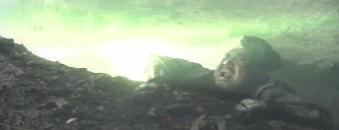
Seeing the god suddenly get so proactive, Kozasa falls
to her knees before it, begging Majin to save her brother and punish
the wicked Samanosuke. Meanwhile, at the fortress, Tadafumi and
Kogenta are tied to large crosses, awaiting their fates. Kozasa,
sensing no reaction from the idol, offers her life to Majin and
attempts to throw herself over the nearby waterfall, stopped only
by the Boy. This is apparently good enough for Majin. The rock and
earth covering the lower half of the idol falls away, and the fifty-foot
statue walks out into the clearing. Kozasa prostrates herself
before it, and the idol gestures before its face: the stone mask
disappears, revealing the true face of Majin, alive, green, and
looking very pissed-off.
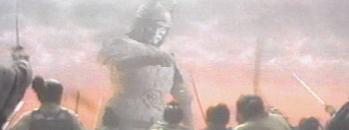
Samanosuke orders his henchmen to stab his prisoners
with their long spears; this was what the old retainers and rebels
were waiting for, as they attack. Unfortunately, this is what the
wily Samanosuke was also waiting for, as his concealed riflemen
and archers make short work of the revolution. After a hardy bad
guy laugh, Samanosuke orders the execution to proceed.
But once more, Tadafumi and Kogenta are spared, as
black clouds obscure the sun and a blue fireball buzzes the courtyard,
eventually hitting the ground and becoming the living Majin, who
proceeds to take apart Samanosuke's nice new fortress and smish
all his henchmen in varying ways. Samanosuke himself, of course,
gets the royal treatment; pursued through his castle like a sniveling
cur, he is finally caught by Majin and carried into the courtyard
like a doll (well, it's not that obvious...). Majin then
places the despot against a ruined wall and, plucking the chisel
from its own forehead, proceeds to nail the villain there, like
a grotesque butterfly.
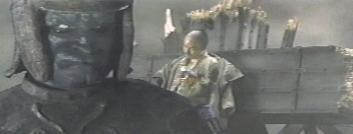
Which would all be well and good, except that we now
find out why everybody wanted Majin to stay put in the mountain
- the idol now turns its wrath upon the villagers. Only Kozasa,
once more offering her life and letting her teardrops fall on his
stone feet, stops Majin's rampage. He fireballs away again, leaving
the good guys to pick up the pieces, and to await once more a parade
of injustice to awaken him from his cold sleep.
This is why the Majin movies are not your average
kaiju: the title creature takes a nap through the first two-thirds
of the movie. They're more like morality plays than full-blown monster
movies - the bad guys get to be really bad for an hour, then Majin
comes to life, and the bad guys all suffer really bad deaths.
It puts you in mind of a generic episode of Kung Fu, where
you sit through forty-five minutes of "Hey, Chinaman!"
just to see Kane finally kick some butt in the last ten.

Which is not meant to be a negative comment
- director Kimiyoshi Yasuda keeps things interesting, and the payoff
in the final act is worth it. The other intriguing aspect of the
Majin films is the time period; in the absence of jet fighters and
tanks, Majin has to deal with the best technology Samanosuke has
to offer - flintlock rifles, catapults, and (ingeniously) enormous
lengths of chains stretched across the road. These all have the
same effect that jets and tanks have on Godzilla or Gamera (i.e.,
none), but the change of pace is a lot of fun.
Also, it's the religious overtones that appeal to
my Southern Baptist roots - when God is prayed to in these movies,
God eventually comes down and enacts some pretty brutal retribution,
which is, I admit, The Way I Think Things Oughtta Be. And if they
were that way, there was a certain junior high school student of
my unfortunate acquaintance who would have been a grease stain on
the pavement long, long ago (or now, seeing as how Majin
seems to work at a very leisurely pace. I'm relatively certain the
bully in question either beats his wife, children, or dogs, wherever
he is now).
Okay, psychodrama now over...
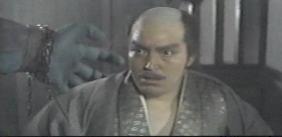
Mention has to be made of the work of Effects Director
Yoshiyuki Kuroda, who has managed to put onscreen some of the finest
giant monster footage I've had the pleasure to encounter. Through
careful matching of camera movements, Majin appears to be wholly
real and occupying the same world as the humans he towers over.
The sequence is only marred by a giant rubber hand that looks like
it was on loan from Attack of the 50 Foot Woman. Past that,
the Majin scenes are practically flawless, and entirely satisfying.
ADV Films, those nice people that brought you the
letterboxed Destroy All Monsters, have issued a gloriously
letterboxed edition of Daimajin. There's a little speckle
and wear at the very beginning, but the rest of the print is beautifully
pristine. The widescreen presentation was also a revelation, as
I found myself pondering, again and again, how did I ever think
I had seen this movie? Yasuda makes such full, fruitful
use of the whole frame, the pan-and-scan version of this movie must
have lacked on any number of levels. Daimajin is full of
pretty pictures, and only the jarring inclusion of a couple of hand-held
camera shots spoil the proceedings.
The only downside of the ADV tape might be
in the translation of the subtitles. I curse my fate regularly that
I have one of those brains that doesn't deal well with other languages,
as there at least five I can name off the top of my head I would
love to speak. So I can't really say if the confusing quality
of some of the subtitles is due to a too-literal translation or
possibly a decision to not "localize" it - to make a few
of the more uniquely Asian phrases and concepts more Western.
Majin goes from a spirit to a demon to a god. Is Shinobu really
Kogenta's aunt or is he only employing the Asian honorific for an
older woman?
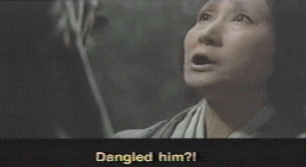
The most glaring - to me - instance is when the Boy
informs Shinobu of the fate of the captured Kogenta: "They
dangled him outside." Dangled him? I remember that Majin,
Monster of Terror introduced me to the phrase "hung by
his heels". It doesn't take that much longer to read
"Hung him by his heels". And Samanosuke's brisk bark to
his spear-weilding executioners to "Pierce them!" is somewhat
less dramatic than one would hope.. Ah, well, I suppose I have to
complain about something....
Because if you're a fan of fantasy, genre, or just
plain Japanese films, Daimajin is a fabulous find. ADV issued
all three Majin films at the same time, which means, in the months
to come, I can safely look forward to the sequels. The last time
I saw Return
of Daimajin was over ten years ago, and I have never seen
Wrath of Daimajin. These are those rarities: kaiju
movies that have not been overexposed by fans, imitators or parodies,
that truly stand on their own as a unique brand of film.
And Devlin and Emmerich will never touch them.